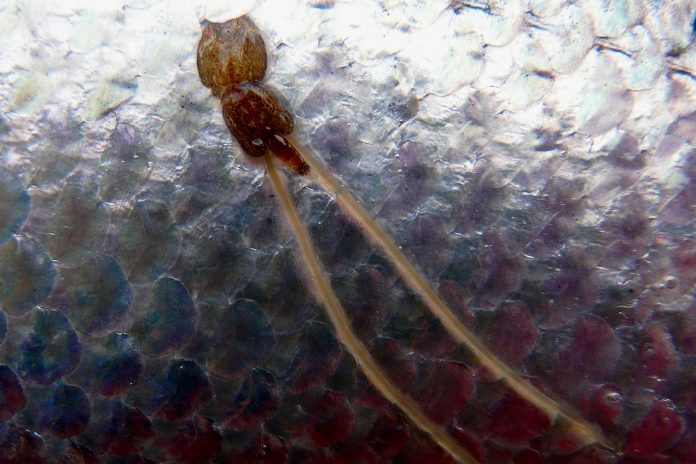Industry pens letter to Cabinet Secretary for Rural Economy Fergus Ewing to call on Marine Scotland to tighten enforcement trigger levels for sea lice.
In a letter signed by Scottish Salmon Producers Organisation CEO Julie Hesketh-Laird, the SSPO has called up Fergus Ewing to urge SEPA to move swiftly and for Marine Scotland to tighten its action level for the enforcement of measures against sea lice.
The SSPO also added that Greig Shetland has joined the organisation.
Last week, Marine Scotland – Scotland’s coastal waters and seas civil service directorate – confirmed that it is now to publish data on sea lice, mortality events and case reports every month.
Below is the letter in full:
“The industry and SSPO is, as you know, looking closely at the recommendations of the Rural Economy & Connectivity report on salmon farming in Scotland. We agree that ‘the status quo is not an option’ and the industry’s commitment to investment in techniques and technologies to drive continuous improvement remains firm as does our support for the various groupings to identify long‐term solutions (such as the Farmed Fish Health Working Group, the Interactions Working Group and the Aquaculture Industry Leadership Group).
“We would urge that SEPA moves swiftly to bring forward its proposed regulatory changes trailed in its recent consultations to end the considerable operational uncertainty and regulatory constraints currently hampering progress.
“One area we urge the Scottish government to address as a priority is that of the lice levels that are currently used to initiate regulatory oversight on a farm by farm basis. The industry‐wide approach to sea lice management of pursuing prevention over cure has made significant strides. Published SSPO data shows that industry‐wide sea lice levels on farms are broadly at their lowest since detailed reporting began in 2013.
“This achievement has in large part been down to the industry’s development of its integrated approach to parasite management using all the tools and techniques available. This has reduced reliance on medicines and has built a broader toolbox of options for parasite control.
“These include investment in preventative measures (the use of lice shields, fallow periods and synchronous farming), continuous good‐practice measures (husbandry) on farms ensuring optimum conditions for fish health, biological measures through the use of cleaner fish, remedial physical measures where required (delousing using thermal and hydro lice removal measures) and approved medicines when required. It is imperative that to ensure the continuation of the downward trend in on‐farm lice levels, all these management options remain available to farmers.
“Clear regulatory thresholds for industry reporting have had their part to play too. Contingent on the availability of all the necessary measures and tools to prevent and treat lice infestations, including access to use of traditional medicines, we would urge Marine Scotland to tighten its action level for the enforcement of measures against sea lice, to help keep momentum and results moving in the right direction.
“SSPO members are ready to move to both a lower action level for reporting lice levels on farms and a tighter enforcement level. Specifically, we recommend Marine Scotland reduces the enforcement trigger level from eight to six and the reporting threshold from three to two adult, female lice. To maintain direction of travel, we recommend a further tightening of the enforcement trigger level to four from February 2020.
“I should also add that since our meeting last month, I am delighted to let you know that we now have Grieg Seafood Shetland Ltd. in membership and so the position I have set out in this letter is one agreed by all the salmon farming industry. We would be happy to meet with you and your officials to discuss our proposals further and the means by which they can be implemented.”
A spokesperson from the Scottish Environment Protection Agency (SEPA), said:
“SEPA works every day to protect and enhance Scotland’s environment. As one of a number of organisations regulating finfish aquaculture, our focus is firmly fixed on developing and delivering a new regulatory framework which will protect the marine environment for the people of Scotland.
“Consequently, across the last eighteen months, we’ve done more science, more analysis and more listening than ever before. Our Scotland-wide, public consultation has provided an invaluable opportunity to engage and interact with local communities on the key issues which matter most to them and hear directly from a diverse range of interests, including NGOs, marine and freshwater fishery groups and representatives of the industry.
“We are firmly committed to getting our proposals right, and will be providing further details on the implementation of the new regulatory regime over the coming months.”
On Monday the 19th of March, a spokeperson for Marine Scotland replied with the following: “The Scottish Government is in the process of reviewing the sea lice compliance policy, which includes consideration on whether current levels for reporting sea lice remain appropriate. We expect to conclude that review soon and welcome that the sector has publicly acknowledged that the status quo is not an option and recognises the need for further improvement.”


